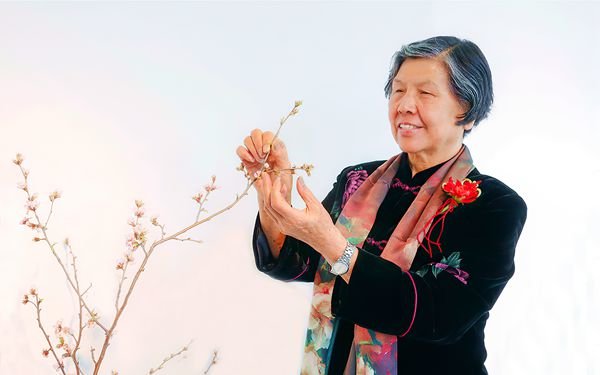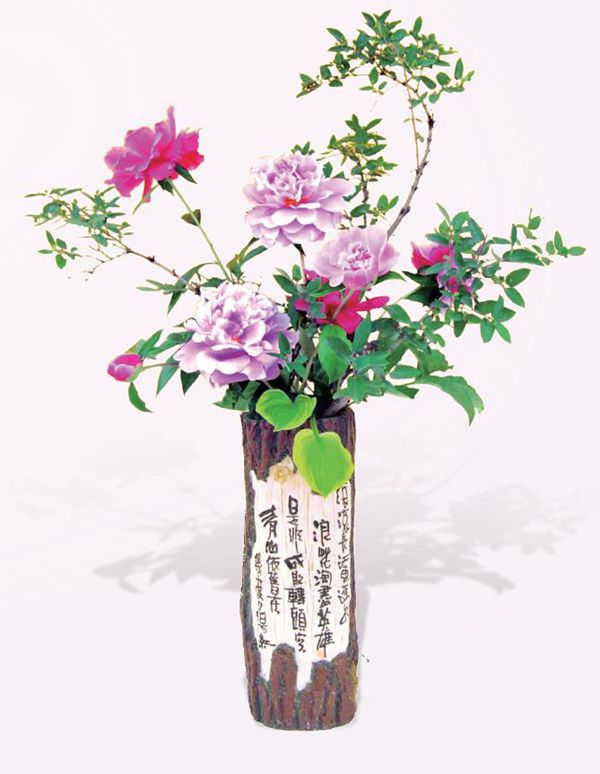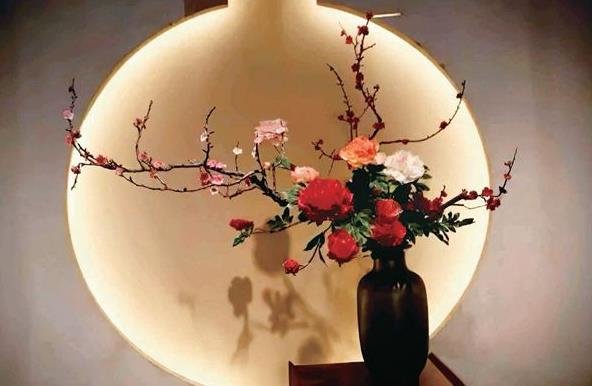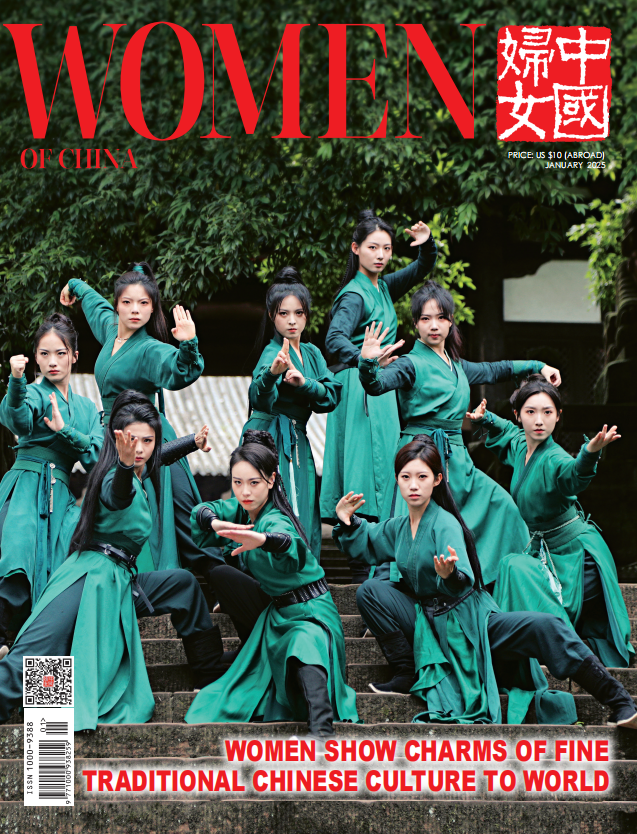Sight Delight! Traditional Chinese Flower Arrangement Essence of Chinese Culture
 |
| Wang Lianying |
In Chinese culture, different plants represent different human characteristics. For example, lotus is seen as lofty and virtuous; bamboo is upright; chrysanthemum is unyielding, in full bloom amid frost; and plum blossoms brave the cold of winter. For thousands of years, a craft — namely traditional Chinese flower arrangement — has added elegance to plants. The art form, which has a history of 3,000 years, is the origin and representative of the Oriental flower arrangement art.
In this art, the term "flower" is a general name that refers to various plants (with ornamental value), including flowers, branches, leaves, trunks and dead woods. Given its vast land, diverse terrains and different climates in various regions of the country, China boasts a great variety of trees, shrubs, vines and grass, which become a veritable treasure trove for flower arrangement.
Over the past 3,000 years, China's social and economic conditions have changed, and so have artistic styles. As society has evolved, the art of flower arrangement has become increasingly popular among Chinese. Approved by the State Council, the art of traditional Chinese flower arrangement was added to the list of the country's items of intangible cultural heritage on June 7, 2008.
In ancient China, under the influence of the philosophy of the unity of people and nature and the farming culture, people revered and loved nature, and plants were their inseparable companions. Also, influenced by primitive religions (especially witchcraft), Chinese ancestors believed people and plants could communicate telepathically. Therefore, the ancestors used plants to worship heaven, to pray for favorable weather and to thank their forefathers for their protection. That was the embryonic form of traditional Chinese flower arrangement. Apart from worshipping, flowers were also made into bouquets to beautify people's lives, to express love, and to honor virtue.

During the Qin (221-206 BC) and Han (206 BC-220 AD) dynasties, flowers were arranged in containers. When it came to the prosperous Tang (618-907) and Song (960-1279) dynasties, the art of flower arrangement reached its zenith. The Tang palace often held peony flower arranging pageants with strict procedures.
During the Song Dynasty, utilization of arranged flowers became social etiquette among ordinary people.
However, the course of the development of the art form is full of twists and turns. It was dealt a blow in the Yuan Dynasty (1206-1368), when the Mongols ruled the Central Plain, and the Han literati, who did not want to work for the Mongols, had no choice but to hide in the mountains, composing poems and arranging flowers. During the period, the art of traditional flower arrangement reached rock bottom. Due to some historical reasons, the development of the art form remained stagnant from 1840 to 1978. It was not until China implemented its policy of reform and opening-up in 1978 that the art form was revived.
Octogenarian's Persevering Efforts
Due, in part, to the persevering efforts of Wang Lianying, an octogenarian, to promote the art of traditional Chinese flower arrangement worldwide, the art form has become increasingly popular among people around the world. Wang was a professor with the School of Landscape Architecture, under Beijing Forestry University, before she retired. During the past three decades, she has dedicated to studying the traditional Chinese flower arrangement.

In 1956, Wang came to Beijing to study landscaping in Beijing Forestry University. Since she graduated from the university in 1960, she has been teaching flower arrangement (at the university).
Wang was aware that before China implemented its policy of reform and opening-up in 1978, the domestic flower market was dominated by flower arrangement artworks created by foreigners, such as French and Japanese.
"At that time, many elderly artists in Hong Kong told me, through phone calls, they would like to send artists to China's mainland, to help us improve our skills needed to arrange flowers. I felt bitter when I received such a call," recalls Wang. Determined to establish China's studies on flower arrangement, she began studying historical documents (on the art form) prior to the Qing Dynasty (1616-1911). In 1987, she and one of her colleagues set up the Beijing Flower Arrangement Art Association.

Wang led the association's members in traveling to museums and galleries across the country to collect information about the traditional Chinese flower arrangement. They recorded all the materials related to the history of the development of the art form in several museums in Xi'an (capital of Northwest China's Shaanxi Province), and brought the information back to Beijing.
Given the tremendous efforts of Wang and her team members to promote the art form during the past three decades, the traditional Chinese art has become increasingly vibrant. Now, observing the natural properties of different plants has become a part of Wang's life.
Nature's Craftsmanship
In Wang's eyes, Chinese aesthetics stresses the spiritual connotations expressed by art works. When they create flower arrangement artworks, craftspeople follow three basic principles: Adoring nature, learning from nature, and presenting nature in a better way. The use of all these techniques leaves no trace of human element, which makes the art very natural.
When selecting materials for flower arrangement, artists strive to "take their forms, seek their meanings, understand their connotations." The artists should not only show the plants' natural beauty, but also symbolically convey the plants' humanistic spirit. For example, when an artist inserts lotus flowers in a vase, he/she should show not only the flowers' elegant, graceful natural beauty, but also its noble "temperament."

As an inheritor of the intangible cultural heritage, Wang has been committed to promoting the craft of creating the traditional flower arrangement artworks over the years. She and other teachers with Beijing Forestry University have provided training to help trainees improve their skills needed to create the artworks. Wang has many expectations for the younger generation. For example, she hopes they will always treasure plants' lives. She suggests the young people should follow the plants' natural shapes, when they cut the plants' various parts (including branches, buds, leaves, flowers, fruits and vines), to create vibrant art works.
In the future, the association plans to help young people, who love the art, become professional flower arrangement artists.
Photos Supplied by Wang Lianying
(Source: China Today/Women of China English Monthly May 2023 issue)
Please understand that womenofchina.cn,a non-profit, information-communication website, cannot reach every writer before using articles and images. For copyright issues, please contact us by emailing: website@womenofchina.cn. The articles published and opinions expressed on this website represent the opinions of writers and are not necessarily shared by womenofchina.cn.






.jpg)

 WeChat
WeChat Weibo
Weibo 京公网安备 11010102004314号
京公网安备 11010102004314号